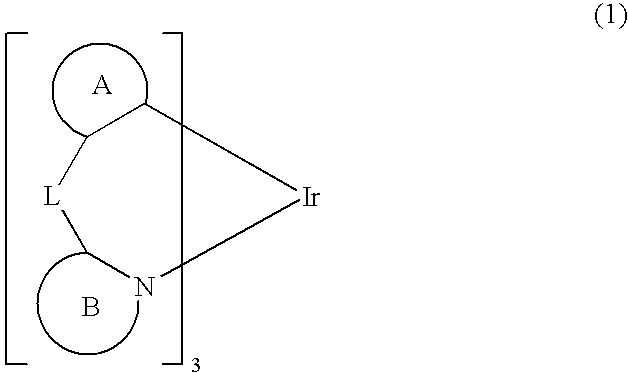Process for Producing Ortho-Metalated Complex of Iridium With Homoligand
a technology of iridium and complexes, which is applied in the direction of organic chemistry, chemistry apparatus and processes, indium organic compounds, etc., can solve the problems of complexes with low yield, extremely low yield, and high cos
- Summary
- Abstract
- Description
- Claims
- Application Information
AI Technical Summary
Benefits of technology
Problems solved by technology
Method used
Image
Examples
example 1
[0044]In a three-necked flask equipped with a reflux condenser was placed 100 ml of glycerin and the flask was swept free of air by blowing N2 for 3.5 hours. Thereafter, 2.0 g of iridium(III) acetylacetonate, 7.5 g of 2-phenylpyridine, and 3.3 g of tartaric acid were added and, in a nitrogen atmosphere, the mixture was heated under reflux in an oil bath at a bath temperature of 200-210° C. with stirring for 10 hours. Upon completion of the reaction, the mixture was cooled to room temperature, 30 ml of ethanol and 300 ml of 2N HCl were added, the mixture was stirred, and the precipitate was filtered. The precipitate was transferred to a beaker, washed with 50 ml of ethanol with stirring, and filtered again. The precipitate thus obtained was transferred to a 100-ml eggplant-shaped flask, 60 ml of acetonitrile was added, and the mixture was heated with stirring in an oil bath at a bath temperature of 100° C. for 1 hour. The mixture was cooled to room temperature and the precipitate was...
example 2
[0045]In a three-necked flask equipped with a reflux condenser was placed 100 ml of glycerin and the flask was swept free of air by blowing N2 for 3.5 hours. Thereafter, 2.0 g of iridium(III) acetylacetonate, 7.5 g of 2-phenylpyridine, and 3.3 g of tartaric acid were added and, in a nitrogen atmosphere, the mixture was heated under reflux in an oil bath at a bath temperature of 200-210° C. with stirring for 44 hours. Upon completion of the reaction, the mixture was cooled to room temperature, 30 ml of ethanol and 300 ml of 2N HCl were added, the mixture was stirred, and the precipitate was filtered. The precipitate was transferred to a beaker, washed with 50 ml of ethanol with stirring, and filtered again. The precipitate thus obtained was transferred to a 100-ml eggplant-shaped flask, 60 ml of acetonitrile was added, and the mixture was heated with stirring in an oil bath at a bath temperature of 100° C. for 1 hour. The mixture was cooled to room temperature and the precipitate was...
example 3
[0046]In a three-necked flask equipped with a reflux condenser was placed 100 ml of glycerin and the flask was swept free of air by blowing with N2 for 3.5 hours. Thereafter, 2.0 g of iridium(III) acetylacetonate, 7.5 g of 2-phenylpyridine, and 9 g of tartaric acid were added and, in a nitrogen atmosphere, the mixture was heated under reflux in an oil bath at a bath temperature of 200-210° C. with stirring for 5 hours. Upon completion of the reaction, the mixture was cooled to room temperature, 30 ml of ethanol and 300 ml of 2N HCl were added, the mixture was stirred, and the precipitate was filtered. The precipitate was transferred to a beaker, washed with 50 ml of ethanol with stirring, and filtered again. The precipitate thus obtained was transferred to a 100-ml eggplant-shaped flask, 60 ml of acetonitrile was added, and the mixture was heated in an oil bath at a bath temperature of 100° C. for 1 hour. The mixture was cooled to room temperature and the precipitate was filtered, w...
PUM
 Login to View More
Login to View More Abstract
Description
Claims
Application Information
 Login to View More
Login to View More - R&D
- Intellectual Property
- Life Sciences
- Materials
- Tech Scout
- Unparalleled Data Quality
- Higher Quality Content
- 60% Fewer Hallucinations
Browse by: Latest US Patents, China's latest patents, Technical Efficacy Thesaurus, Application Domain, Technology Topic, Popular Technical Reports.
© 2025 PatSnap. All rights reserved.Legal|Privacy policy|Modern Slavery Act Transparency Statement|Sitemap|About US| Contact US: help@patsnap.com



